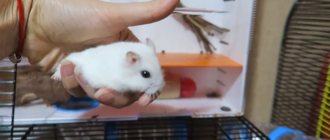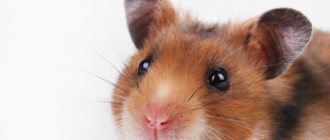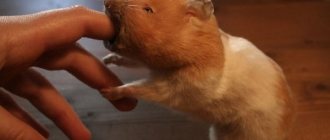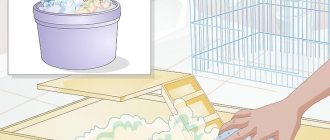- home
- General information
28.03.2018
The hamster is an animal of the steppe; in nature, it has practically no opportunity to fall from anywhere. Therefore, genetically, he is completely unadapted to falling:
- He orients himself in space using the sense of smell and touch (his blind eyes are not able to see the cliff).
- The hamster lacks a tail, which helps tailed animals turn over in flight and reduce the speed of their fall.
- His limbs are too weak to bear the weight of his body during landing.
Rodents are not at all afraid of heights, because they do not know about its dangers. This function is taken on by the pet breeder.
The hamster lies motionless: reasons
Everyone knows about the short lifespan of hamsters. And then a terrible thing happened: it seems that the pet died. Due to excitement, it is difficult to figure out what to do if the hamster lies and does not move, but is breathing. After all, the presence of breathing means that the animal is still alive. Before you run to the veterinarian, you need to try to figure out why your pet is lying motionless. Pay attention to other signs: whether the eyes are closed, how often the rodent breathes. If the eyelids are closed and breathing is calm, the hamster may simply be fast asleep.
What to do first
If your child falls out of bed, it is important to remain calm. As long as the child’s fontanels are not closed (large in the middle of the crown and small at the back of the head), in case of an impact they will protect the baby from fractures of the cranial bones
When a baby or toddler falls out of bed, it is important to remain calm and quickly assess the situation. Call 911 immediately without touching the child if:
Call 911 immediately without touching the child if:
- He lost consciousness
- The child is motionless (before the fall he was active, perhaps crawling and rolling over, after the fall he lies motionless).
- Convulsions appeared (the child’s arms and legs involuntarily twitch, eyelids tremble).
- Coordination is lost. This symptom can be observed in a child who already knows how to sit and perform actions with toys. For example, before the fall, he skillfully put objects into some container, but after the fall he cannot stand or stumbles every 2-3 steps.
- Vomit
- Sudden severe lethargy and drowsiness of the child.
- Strong crying
- Bleeding from the nose (this can be a rather dangerous condition, which indicates a serious injury to the cranial bones. Bloody or, conversely, clear discharge may appear from the ears).
Moving a child with a head or spinal injury can cause serious complications
However, if the child is in an area where there is a risk of further injury, he or she can be carefully moved to a safer location
If your baby is vomiting or having a seizure, gently turn him onto his side. Make sure baby's neck is straight while you turn over
Check him over carefully, paying close attention to his head and any bumps, bruises or other injuries. Check the rest of the baby's body, including the arms, legs, chest, and back. If you see damage, under no circumstances should you adjust the joints yourself or touch or press on the bones.
You can apply cold to the site of the bruise - any food from the freezer will do for this. They need to be wrapped in a soft towel and held where the redness has formed. If there is a wound, it needs to be treated with hydrogen peroxide to stop the bleeding, apply a sterile bandage and wait for the doctor to arrive
If you see damage, under no circumstances should you adjust the joints yourself or touch or press on the bones. You can apply cold to the site of the bruise - any food from the freezer will do for this. They need to be wrapped in a soft towel and held where the redness has formed. If there is a wound, it must be treated with hydrogen peroxide to stop the bleeding, apply a sterile bandage and wait for the doctor to arrive.
If the child does not show any visible signs of injury, observe him for a short time to make sure nothing changes.
Defensive stance
One of the reasons for a rodent falling on its back may be a defensive reaction. If a hamster begins to defend its territory from another rodent, it will often take a defensive stance. It allows the little hamster to appear more menacing and strong.
Read also: What to do if my mother hits me
What exactly characterizes the stand:
- Falling on your back.
- Staying in one position for a certain period of time.
- Flatten ears.
- Raised paws up.
With these actions, your pet defends its right to territory and will fight for it to the end. You should not touch him in this state; there is a fairly high probability that the hamster may bite you. An animal in a fit of aggression may mistake you for an enemy, so be careful.
Rehabilitation after a fracture
Complete recovery of a paw after a fracture can take 2 to 4 weeks. During this period, mobility restrictions are still relevant. If for some reason the animal needs to be returned to the cage, all ladders, running wheels and other toys should be removed from it. Change the litter regularly.
After consulting a doctor and providing first aid, the pet should be closely monitored. After the first three days, you can judge the success of the therapy. If the paw begins to dry out or turn black, you need to urgently consult a doctor - amputation is required. However, sometimes animals simply gnaw off an injured limb; this instinct is inherent in them by nature.
Treating limb injuries at home
Is there a veterinary clinic in the locality where you live? Then don’t hesitate and take your pet there - qualified assistance is provided to you and the rodent. What should you do if a hamster breaks its leg, and there is not even a veterinarian in your locality or there is no way to contact one now?
First
and your most important action is to limit the animal’s movement. Any movement of the damaged paw is accompanied by severe pain.
In case of an open fracture, the wounded limb should be treated, that is, disinfected, and a plaster cast should be applied.
Second
– instead of bedding, use pieces of paper napkins so that the rodent does not dig into the bedding with its damaged paw.
Third
– Provide your pet with proper nutrition. It should contain quite a lot of calcium and protein, that is, in addition to the grain mixture, introduce the following products into the rodent’s diet:
- low-fat kefir;
- the fat content of cottage cheese and yogurt should be no more than 1%;
- white and yolk from one;
- (lettuce leaves).
Fourth
After the first three days of treating an injured hamster, you will be able to observe the dynamics of the therapy. Recovery of the limb will not occur if the rodent's paw begins to dry out or turn black. Here, contacting a specialist is inevitable. Sometimes the animals themselves amputate their limbs by simply gnawing off their paws. This outcome is quite depressing, but do not fall into despair. Hamsters are animals that can live a full life (100%), having 3 legs. Most often, hamsters' limbs do not die - the bones on the paws of rodents grow together perfectly. Try to be very attentive to your small pets. And then you won’t have to go to a veterinary clinic to get qualified help.
Rehabilitation after a fracture
Complete recovery of a paw after a fracture can take 2 to 4 weeks. During this period, mobility restrictions are still relevant. If for some reason the animal needs to be returned to the cage, all ladders, running wheels and other toys should be removed from it. Change the litter regularly.
After consulting a doctor and providing first aid, the pet should be closely monitored. After the first three days, you can judge the success of the therapy. If the paw begins to dry out or turn black, you need to urgently consult a doctor - amputation is required. However, sometimes animals simply gnaw off an injured limb; this instinct is inherent in them by nature.
How do hamsters die?
The death of a pet can be expected or sudden. Hamsters can die screaming or absolutely silently. Here are the signs that your hamster is dying suddenly:
- if the pet is sick, he will cry, gradually his voice will turn into a fading wheeze;
- if a pet falls from a great height, it can damage its spine, in which case its body will be limp, and death will occur within an hour;
- The paralysis of an animal can be determined by its immobility. Khoma breathes, can eat a little, but is no longer able to move independently. From now on, the hamster's days are numbered.
In the case of prolonged illnesses and old age, the following external signs will help to recognize the approaching death of the animal:
Actions when bitten
Depending on the breed, hamsters may behave differently with new owners. For example, a decorative hamster can bite until it bleeds. But they are not predisposed to contracting the virus. The Dzungarian species shows aggression if it is not yet accustomed to people. The Syrian bites rarely, but bites the most painfully due to its size and greater strength.
If you are bitten by a domestic animal, you do not need to immediately run for a vaccine. If a rodent dies suddenly, an examination must be carried out to find out the cause of death.
Remembering that you were recently bitten by a hamster, it is not too late to vaccinate. It is carried out within 14 days after the bite. But you don’t just need to take the course, since it is unsafe and requires strict compliance with the instructions.
If, having started the vaccination course, more than 10 days after the bite the hamster is alive and has no symptoms, you can stop treatment. Rabies may not appear for a long time, and the virus can be detected in saliva approximately ten days before the first symptoms appear. But in herbivorous hamsters it cannot be detected in the saliva, since the virus only affects nerve cells.
Consequences of "flights"
What happens if a hamster falls from a height? Falling from any height is a fairly common occurrence for domestic hamsters. Most rodents with long tails are endowed with the ability to turn over “in flight” and land on their paws, but hamsters, unlike long-tailed rodents, do not roll over this way.
Therefore, even falling from the height of a desk or kitchen table onto a soft surface (linoleum or carpet), the animal can receive serious injuries.
After falling from any height, even if the animal has not received any serious injuries, pet hamsters act like monkeys, that is, they imitate their death - they lie on their backs and barely breathe . This behavior of a domestic rodent indicates that the animal has experienced a severe shock and needs time to recover. I would like to note that hamsters are very nimble, but rather clumsy animals. Leaving them unattended, even for a moment, you may notice with annoyance that your hamster has fallen from a great height and is lying on the floor with its paws up.
Having found your “pilot” in this state, carefully transfer him to the cage, place it closer to the warmth and create twilight for the fluffy. Your next steps are to monitor the baby, check how the hamster feels every hour, but do not disturb him.
If the rodent can soon get up and begin to actively run around the cage, eats well, and willingly leaves its house - everything is fine with the animal. To relieve stress in an animal, support its body by simply giving special vitamins for rodents.
When all is not well
If, while watching the glider, you notice that he is trying to be alone or has begun to sleep more than usual, and his fur looks not only wet, but also disheveled - carefully examine your hamster. First of all, pay attention to the rodent's mouth. It happens that hamsters break their incisors when they fall. In this case, provide your pet with vitamins and soft food.
It often happens that the hamster gets up, but its movements are rather unnatural (staggering, limping) - this indicates damage to the internal organs or fractures of any bones in the pet. In case of such injuries, you should immediately contact a specialist - a veterinarian; he will be able to identify the problem and prescribe the necessary specialized treatment for your baby. Self-medication in this case will not lead to anything good.
Fall Prevention
To avoid your hamster falling from a height, try not to lift the animal high on your palm, do not pick up an untamed animal, do not leave it unattended on a table or sofa, and do not buy multi-tiered cages for the animal. If you have already bought it, try to protect it from falls by re-arranging the floors with cardboard or plastic. Now you know what needs to be done not only when the hamster “flies” to the ground, but also to prevent this from happening. Be very attentive to your pets and then they will be healthy, and you will be able to get only pleasant impressions from communicating with them.
Sources of danger
Falling from furniture
It's worse if the floor is tiled. But a relatively soft surface (linoleum, carpet) will not protect your pet from injury: hamsters do not know how to roll over and group in flight. Fortunately, if a hamster falls from furniture, it can get away with a slight fright.
Fall from hand
If a hamster falls from a height of human height, damage cannot be avoided. The animals have an independent character and can escape from the hands of a loving owner, slipping out and falling to the floor. It happens that suddenly the hamster bites painfully, and the person involuntarily throws the tiny rodent away.
In a cage
Even in his own house, a pet can climb up the bars of a lattice cage and fall down. Therefore, multi-tiered housing for hamsters is not recommended.
Useful video
Often you may not notice your pet's injury immediately, but after several days, when the hamster's paw changes color and the hamster limps.
But it is important to provide the right help as soon as you notice the animal’s suspicious behavior.
Hamsters are small, very active animals that love to run and play. Unfortunately, the active lifestyle of a furry pet often leads to injuries. Additionally, if you have multiple hamsters that don't get along very well, they may fight and cause some pretty serious injuries to each other. If you notice that your pet has been injured, you need to act quickly: provide the pet with the necessary assistance and help it quickly return to a normal, active life.










